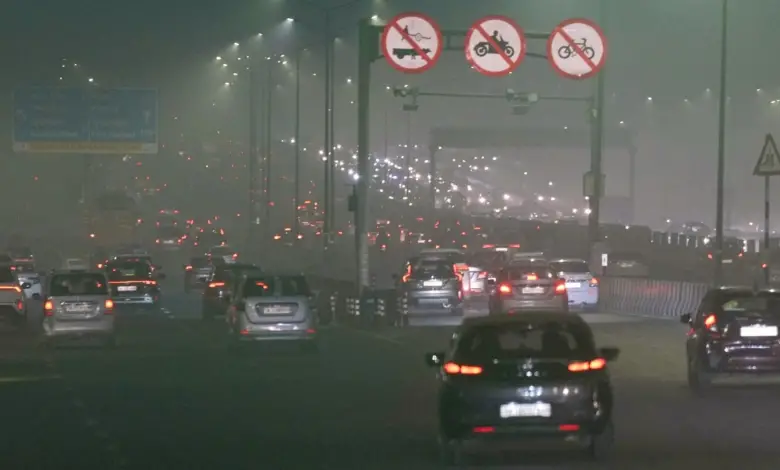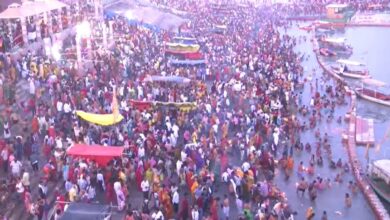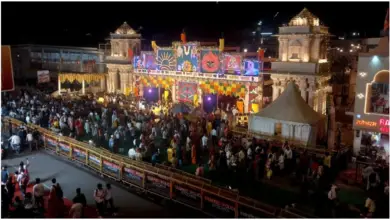Delhi Air Pollution – ‘The entire city has a grimace on its face…’, announcement of ban on ban, then how did Delhi become a gas chamber, where is the mistake happening? – Announcement of ban GRAP in Delhi NCR how did Delhi become gas chamber where is mistake air pollution AQI ntc

The whole city has the sorrow on its face
The condition of the heart is the condition of Delhi.
confusion, suffocation, despair, heat, curb, longing
It’s so crowded that it’s hard to even breathe.
The winds have the right to wander in the city
It is difficult to leave the house with a lamp
These lines of famous poet Malikzada Manzoor Ahmed are describing the bad weather of Delhi-NCR. The National Capital Region has become a gas chamber. This morning is the most dangerous in this season i.e. 2024. The average level of AQI has reached 481. This is the worst category so far. Almost all stations are in the serious plus category (450+). AQI has been continuously increasing in Delhi since Sunday. The rules of GRAP-4 have come into effect from today. The government can now take decisions like odd-even rule, complete closure of offline classes, 50% attendance in offices and other emergency measures. But, the big question is whether there is hope of further reduction in air pollution?
Actually, Delhi-NCR has come under the grip of Grape-4, but the effect of efforts to improve air quality is not visible on the ground. Every year restrictions upon restrictions are imposed. Rules are made and big announcements are made, but all these do not prove to be effective in reducing pollution. Last year too, Group 4 restrictions were imposed, but after 14 days, when the weather suddenly changed and it rained, there was relief from pollution. This year, there is a period of restrictions in Delhi-NCR since Diwali. But, there is no reduction in pollution figures. It can be said that we have made claims of taking various measures and efforts since October, but today instead of reducing the pollution has reached Severe Plus. The havoc of both pollution and fog can be seen in future also.
How effective is Grape 4?
The air quality crisis in Delhi-NCR becomes serious every year. Due to the Air Quality Index (AQI) being in the severe plus category, normal life is being badly affected. The government has implemented the fourth phase of the Graded Response Action Plan (GRAP) from today, which is considered the most stringent measure to deal with air pollution.
Last year, the first phase of GRAP was implemented in Delhi-NCR on 6 October, the second phase on 21 October, the third phase on 2 November and the fourth phase on 5 November. In 2023, Grape 4 was in force for a total of 14 days. On November 19, when the AQI level reached 319, Group 4 restrictions were lifted and instructions were given to remain in Group 3 until the air remained clean. Similarly, in the winter of 2022-23, Grape 4 had to be implemented for only 3 days.
Also read: Air pollution at danger level in Delhi, all schools closed except 10-12th
How did you get relief from pollution last year?
Last year, there were restrictions in Delhi-NCR for about one and a half months. On November 5, 2023, when the AQI level reached the highest level of 454, Group 4 was implemented. However, there was a slight decrease in pollution from the next day and the AQI was around 421 on 6 November, 395 on 7 November, 426 on 8 November and 437 on 9 November. But on November 10, it rained and the AQI dropped to 279. After that, Delhi-NCR got a big relief due to the sudden change in the weather and the air also started clearing. AQI was recorded 220 on 11 November, 218 on 12 November, 358 on 13 November, 397 on 14 November, 398 on 15 November, 419 on 16 November, 405 on 17 November, 319 on 18 November. After that the government removed the restrictions of Grape 4 and implemented Grape 3.
Situation worsens again due to pollution in Delhi…
The pollution situation is bad again in Delhi-NCR. Stifling winds are blowing. Since Monday morning, there has been dense fog and haze due to pollution. The cold has also hit hard. Zero visibility is being recorded at many places. CPCB figures say that Delhi has become the second most polluted city in the country. Here the figure has crossed 450 in 13 different stations. Bahadurgarh of Haryana is the top polluted city in the list with 445 AQI.
There are a total of 40 monitoring stations in Delhi and data from 32 stations says that the air quality here is in the severe (AQI 400 plus) category. The situation is such that even in the afternoon, vehicles have to move on the roads with lights on. By 4 pm on Sunday, AQI had reached 441 and by 7 pm it had increased to 457. AQI 417 was recorded on Saturday.
Also read: Why does the pollution graph go up in winter, what is the Great Smog of London, which took thousands of lives in four days?
Why is Delhi becoming a gas chamber?
Every year concern is raised about the deteriorating air quality in Delhi. Rules are also made regarding management and the Supreme Court also gives instructions. But the situation does not improve. The main reason for this is considered to be poor management in Delhi-NCR. In Delhi, people are forced to breathe poisonous air throughout the year, but as November approaches, everyone starts realizing how much worse the situation has become. A new study by Delhi-based environmental think tank ‘Centre for Science and Environment’ (CSE) says that the role of stubble burning in Delhi’s air pollution is only 8 percent. Vehicles have become the biggest problem in turning Delhi into a gas chamber. The emissions from these vehicles are causing pollution and people are falling ill. Data says that the estimated share of vehicles’ carbon emissions is around 13 percent to 15 percent. After that, emissions are being produced by burning stubble. The situation has worsened due to stubble burning in the surrounding states. The level of pollutant particulate matter (PM2.5 and PM10) in the air is also the highest here. The restrictions of Group 4 are also focused on the control of vehicles.
– There is a ban on diesel vehicles older than 10 years and petrol vehicles older than 15 years in Delhi, but this is not effectively controlled. There is a lack of regular inspection and strict monitoring of vehicles, due to which old and polluting vehicles continue to ply on the roads. Delhi government has often been alleging entry of such vehicles from nearby states.
– Delhi has more than half the number of BS-III and BS-II vehicles. That means there are a total of 60.14 such vehicles. Only 2234 old vehicles were seized in Delhi between October 1 and November 15. Whereas in 2023, 22,397 vehicles were seized. These figures show that this year the action has not been carried out as strictly as before.
– There is a need to strengthen public transport to reduce the increasing use of private vehicles. Although Delhi has an extensive metro and bus network, other NCR areas lack public transport. This has a direct impact on the increasing number of vehicles and pollution.
To reduce the number of vehicles on the roads, the Delhi government had implemented the Odd-Even scheme, in which vehicles with odd and even numbers ply on the road alternately. This plan was successful in providing some relief from air pollution, but it was not adopted as a long-term solution.
Also read: Paper plan, only announcement and smoke in the sky… Why is Delhi-NCR not getting freedom from pollution?
– Congestion and reduction in traffic speed also increases pollution. To reduce traffic jams, road infrastructure will have to be improved. Apart from this, promoting car-pooling, public transport, and cycling can also be beneficial.
– Large scale construction work continues in Delhi-NCR, due to which the level of dust and smoke increases. Rules like spraying water, covering materials, and use of anti-smog guns at construction sites are in place, but they are not followed properly.
– There are strict policies to control pollution coming from the industrial areas of NCR, but their compliance is not ensured. Small industries still use old and polluting equipment and many industries do not follow environmental standards.
– Waste to energy plants in Delhi have also had the opposite effect and are further increasing the toxic smoke in Delhi.
– Burning of garbage and dry leaves in the open increases air pollution. There is a provision for ban and fine for this, but there is lack of monitoring at the ground level. People are unable to give up the habit of burning garbage in the open.
– There are many plans to increase green cover and plant trees, but due to urbanization it becomes difficult. The work of planting new trees and taking care of the already planted trees is done at a slow pace.
For how many days have there been restrictions in Delhi?
Grape-1 was implemented in Delhi-NCR on 14 October this year. At that time Delhi’s air quality index had crossed 200. Grap-1 was implemented. After that, GRAP II was implemented from 8 am on 22 October 2024. When the figures did not improve, the decision was taken to implement Grape-3 after 25 days i.e. on 15th November. A complete ban was also imposed on construction and demolition activities. Now three days later, from November 18, Grape-4 has been implemented. The havoc of pollution was visible in Delhi-NCR even before Diwali. After Diwali, the situation continued to worsen. Now the situation is such that breathing air has become more difficult.
Also read: ‘Gas chamber’ like situation in Delhi-NCR, decision to implement GRAP-4 after increasing pollution
Hearing in Supreme Court today
An important hearing will be held in the Supreme Court today on the petition regarding implementing measures to deal with air pollution in Delhi-NCR. It has been said in the petition that if the pollution situation in Delhi worsens then it can become the most polluted city in the world. The petitioner had demanded an immediate hearing citing the existing pollution. The petitioner said that the Air Quality Management Commission should be informed about the steps being taken to deal with the situation. Earlier on November 11, the Supreme Court had taken cognizance of the violation of firecracker ban order during Diwali and had remarked that no religion supports polluting activities. The court had directed the Delhi government to decide within two weeks whether the firecracker ban should be extended for the whole year or not.
What is GRAP?
GRAP-1: Poor (AQI 201-300)
GRAP-2: Very poor (AQI 301-400)
GRAP-3: Severe (AQI 401 to 450)
GRAP-4: Very severe (AQI more than 450)
What are the restrictions in Delhi now?
– The Centre’s Air Quality Panel (CQM) has imposed Stage-4 restrictions of the Graded Response Action Plan (GRAP). This is considered the strictest pollution control measure. There will be a ban on entry of all trucks coming from outside Delhi. However, CNG-electric vehicles (trucks) carrying essential goods have been exempted from the ban.
– There will be a ban on medium and heavy diesel powered goods vehicles registered in Delhi. Only vehicles carrying essential goods will be exempted. There will be a ban on diesel-powered four-wheelers in Delhi-NCR. However, emergency vehicles have been exempted. Only BS-6 vehicles can run in this category.
There will also be a ban on industries in NCR. Where there is no facility of PNG fuel and fuel outside the list authorized by the government is being used, then there will be a ban.
– Industries related to milk and dairy products and medical equipment will be exempted. There will also be a ban on construction and demolition activities.
– All construction activities including highways, roads, flyovers, power lines, pipelines and other public projects will also remain closed.
Also read: Changed office timings in Delhi, steps taken to deal with pollution and traffic jams
– CQM suggested online teaching for class 6 to 9 and class 11 students. It also recommended that offices in the National Capital Region (NCR) operate at 50 per cent capacity, with the rest working from home.
– The option to work from home can be kept for central government employees. State governments may also decide to close colleges, limit non-essential business activities and enforce odd-even vehicle rules.




